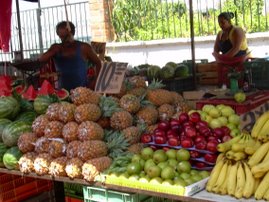 I am putting this photo of our pink bouganbilia bush as the first photo on this entry because I am so proud of it. Our bouganbilia had been healthy but without many blossoms. Shortly before Pixie left she suggested that our problem might be that they were getting too much water. Since she's been gone, I've been abandoning my "if a little water is good, more is better" philosophy, especially with the bouganbilia. You can see the results! Here are some other photos of the garden as it looks today:
I am putting this photo of our pink bouganbilia bush as the first photo on this entry because I am so proud of it. Our bouganbilia had been healthy but without many blossoms. Shortly before Pixie left she suggested that our problem might be that they were getting too much water. Since she's been gone, I've been abandoning my "if a little water is good, more is better" philosophy, especially with the bouganbilia. You can see the results! Here are some other photos of the garden as it looks today:

The winter months of December and January are somewhat dormant, but now, in late February, I am seeing that the plants are growing more and blooming. A big project we've been working on is to plant a vine wall of "copa del oro" in the space on the west side of our terrace to block the setting sun which can make it too hot to sit out on the terrace during the late afternoon. Our plan is to have the vines block the sun with an attractive wall of plants. I was hoping to have it ready for the hottest months of April and May, but it looks as though it may take a bit longer:

In my last post, I discussed food shopping. Today I will explore some other costs of living here, using specific dollar amounts, as estimated from the peso conversion. Keep in mind that the conversion was 10:1 and is now aobut 14.5:1, so we are getting about 40% more pesos for the dollar. I don't know how long this will continue, but for now, it give us more buying power.
The cost of owning a home here is very inexpensive compared to our house in Maine. This year's property taxes were 950 pesos ($64) and our yearly water bill 2400 pesos ($163). We have no heating system, and our electric bill, if we keep it under 500 kwh per two month period, we get a cheap rate. We've converted to fluorescent bulbs, unplug our microwave and TV at night, and generally try to conserve. We've been doing well. Our last bill showed a usage of 366 kwh for November and December, so the bill was 547 pesos or ($37). Our latest telephone bill, which includes calling here in Mexico plus our DSL internet connection (to which our Vonage phone is connected) was 479 pesos ($35.50). We pay our monthlyVonage bill ($30) via our credit card which gives us unlimited calling to the United States. We generally fill our propane tank (dryer, stove, and hot water) once every 2.5-3 months for 1200 pesos ($81). We change our water filters for the purification system every six weeks at a cost of 360 pesos ($25). So as you can see, the utilities are not expensive. Of course, those who have bigger houses, with pools, pay a much higher rate for electricity, as much as $250-300USD per month.
Maintenance on homes is required and usually consists of sealing the roof every 2-3 years, periodic repair of salitrate (a salt decay) on the walls and subsequent repainting. Labor is not expensive, so maintenance is not a big expense. We have a maid come about 4 hours, one day a week, and we pay her 200 pesos ($14) plus bus fare (12 pesos). Our gardener comes for a couple of hours just to weed and cut the grass for 100 pesos ($7).
Eating out at restaurants is very reasonable. Breakfast is very cheap, usually costing about 60 pesos for a full breakfast ($4). Dinner entrees at most restaurants range from 70 pesos ($4.70) to 120 pesos ($8.00). Beer is about $1.5o while wine can be $2.50 a glass, and margaritas are cheap at about $3.00 or less (all in USD). People tip between 10 and 15%. I like to buy roasted chickens, which are very popular here. For about 80 pesos ($5.40) you can get a delicious roasted chicken including tortillas, salsa, and roasted potatoes. Here is where we buy roasted chicken. It's called the happy chicken, although I doubt that's true!
 Transportation is not expensive. Most people in Mexico cannot afford cars, and buses are readily available. I can stand on the main drag, about a block from our house, and take a bus just about anywhere. It costs 6 pesos to ride into Ajijic or Chapala, and 35 pesos into Guadalajara. Here is a typical commuter bus.
Transportation is not expensive. Most people in Mexico cannot afford cars, and buses are readily available. I can stand on the main drag, about a block from our house, and take a bus just about anywhere. It costs 6 pesos to ride into Ajijic or Chapala, and 35 pesos into Guadalajara. Here is a typical commuter bus.  Driving is similar in expense to the US. Gas, which is sold only through Pemex stations, the national oil company, has remained steady at about 72 pesos per litre (about $1.90) per gallon. There is no self-serve here. Attendants fill your tank and sometimes wash your windows for a tip. Here is what all Pemex station look like:
Driving is similar in expense to the US. Gas, which is sold only through Pemex stations, the national oil company, has remained steady at about 72 pesos per litre (about $1.90) per gallon. There is no self-serve here. Attendants fill your tank and sometimes wash your windows for a tip. Here is what all Pemex station look like:Here are some other places we frequent: (Clockwise, from top left) the Mexican post office where we get our mail, la pescaderia (seafood store), OXXO (equivalent to a 7-11), and a hardware store.
In general, you can live on very little or spend a lot here. Medical care can be expensive, but much cheaper than the US. The difference here is that we usually pay out of pocket for everything. Some drugs are generic and cheap, others very expensive. Pixie had surgery which cost about $2500 total. We are cancelling our private major medical coverage which costs us $3300 a year (with a $2000USD deductable, per event), but the cost is skyrocketing, and we will rely, for serious problems, on IMSS, the Medical Social Service medical coverage which cost us about $500USD per year and includes everything. We've heard both good and bad things about IMSS, but it is what we can afford. Electronic items, like computers, are more expensive here. And, of course, many items we would have no trouble finding, may not be avaialble here. (recent examples: magnifying glass, turkey baster). We live easily on a modest pension here, and we manage to save money for travel back to the states. But we have to watch our money carefully sometimes near the end of the month. We could live cheaper if we had to, and lots of our friends live in more luxurious style. Many also live on much less.
Finally, a word about the drug violence in Mexico. Several of my friends and family members have expressed concern about US media reports of a huge increase in drug violence here. This is true, but misleading. There were thousands murdered in Mexico last year, and the trend is continuing this year. The vast majority are drug reprisal killings against rival drug gangs, police, journalists, and politicians. President Calderon has declared war on the drug gangs, and the spike in violence is a direct result of his efforts. Most of the violence is in the three northern Mexico states, but there have been some killings in Jalisco (the state we live in) and in Michoacan (the next state). I reported a few weeks ago that there was a drug killing in Riberas where we live, but that turned out to be a jealous boyfriend killing. As far as I know there has been no drug violence in this area. People here feel safe and secure. We do not drive much at night, and we take security seriously, as you would in many areas of the US, but we do not feel in any danger. Living in a foreign country, particularly one with problems like Mexico, is always a risk. But, to those of us here, at this point at least, the advantages far outweigh the risks. I suppose it could change. I think the Mexican people were willing to give Calderon a chance, but many here are alarmed at the increase in violence. The PRI may take a different tack if they are elected. The REAL problem, of course, is drug demand in the US. To me, we may be at the point where we need to look at the problem like we did prohibition and legalize drugs. I doubt enforcement efforts will ever work when there is so much profit to be made. We'll see. But don't worry about us; we're safe.
















































































